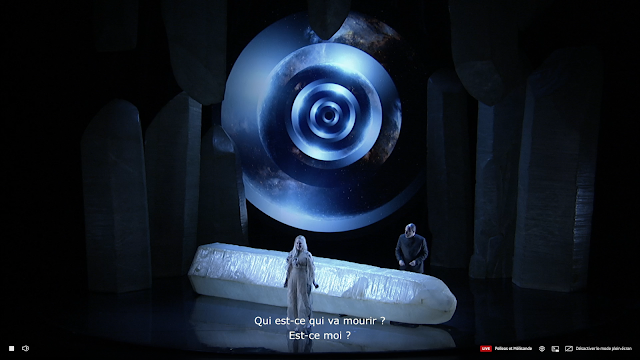Grand Théâtre de Genève (live stream), 18/01/2021
Debussy : Pelléas et Mélisande
Orchestre de la Suisse Romande
Jonathan Nott
This is a co-production originating with Opera Ballet Vlaanderen, which has made it a principle in recent years to more fully integrate the two sides - opera and dance - of the company. In consequence, OBV entrusted its new production of Pelléas et Mélisande to choreographers Sidi Larbi Cherkaoui and Damien Jalet, to a concept by renowned (not to say notorious) concept artist Marina Abramović. Of this trio, Jalet I knew not at all, and the little I had seen of Abramović's work was more of a deterrent, but Cherkaoui was a different story. I've liked everything I've seen of his to date, and wanted to see what he could bring to this most subtle and fragile of operas.
When the curtain rises, we're on a different planet. Inside a thin ring of light on a black mirrored floor, six black-clad dancers, with black kendo-style masks obscuring their faces, weave a cat's cradle of reflective threads in which Golaud meanders, trapped in his forest. Overhead, a globe filled with starlight shimmers magically. In subsequent scenes, the globe/circle shows nebulas and galaxies, eye-like, while giant crystal shards furnish the stage space. The dancers - eight in all - sometimes reflect the action, sometimes the characters, and the choreography is fluid and expressive. The costumes are timelessly elegant, by the Dutch fashion designer Iris van Herpen.
Back in 2016, I complained that Katie Mitchell's production for the Aix Festival lacked water. In a score that fairly ripples with watery references, it seemed almost blasphemous to avoid the issue almost entirely. Yet this production manages to be 'dry', yet utterly magical, mineral and ethereal, light from another planet, with a faint implication that Mélisande is, quite literally, an alien being. It is one of the most beautiful shows I have ever seen, strange and enthralling, coldly exquisite, symbolist, detached yet direct, in a way that some of those productions that try to domesticate this story fail utterly to comprehend.
 |
| L to R : Mari Eriksmoen (Mélisande) and Leigh Melrose (Golaud) Act 5, Pelléas et Mélisande Grand Théâtre de Genève, 2021 (screenshot) |
The singing was uniformly excellent, starting with the French which, for a largely non-Francophone cast, was very good indeed. Mari Eriksmoen was a dignified, composed Mélisande, always a little detached, as this production required of her, and nicely contrasted with Jacques Imbrailo's intense, interiorised Pelléas. Leigh Melrose was an excellent Golaud, driven a little mad by the strange being he has married. It was an interesting touch that the wound he receives in Act 2 never heals, suggesting something wounded inside that never heals either. Yvonne Naef made the most of Geneviève, her letter scene warm and expressive. Matthew Best was a richly sonorous, authoritative Arkel, and Marie Lys a fresh-toned Yniold. Jonathan Nott and the OSR delivered a finely nuanced reading of the score, knitting the whole together with a finesse and subtlety well matched to the visual beauty of the staging.

